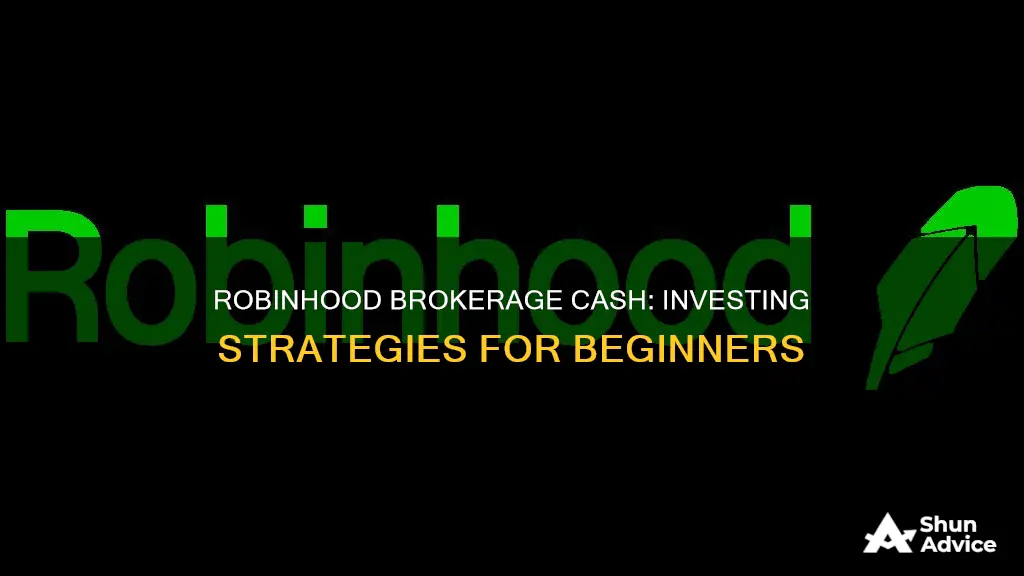
Robinhood is a brokerage app that offers free stock, options, ETF, and cryptocurrency trades. It also provides users with an IRA with a 1% match (3% for Gold members), a streamlined interface, and a high interest rate on uninvested cash. However, it falls short in terms of mutual fund and bond offerings, and its third-party research and data offerings are limited.
When it comes to investing brokerage cash on Robinhood, it's important to understand the difference between brokerage cash and buying power. Brokerage cash is the top-line cash total in your investing account, including funds from unsettled trades and collateral. Buying power, on the other hand, refers to the bottom-line amount of cash available for immediate spending or trading.
- Reinvest it into more stocks, bonds, or ETFs to pursue long-term gains.
- Put it into a short-term debt instrument, such as an ultra-short bond fund, if you need access to the funds in the near future.
- Let it sit and earn interest, similar to a bank savings account.
- Use it to pay bills by setting up a cash management account with Robinhood.
- Spend it on something fun, like a vacation or a nice purchase.
| Characteristics | Values |
|---|---|
| Account fees | No annual or inactivity fees. $100 ACAT outgoing transfer fee. Robinhood Gold costs $5 a month. Instant withdrawals cost a minimum of $2 and a maximum of 1.75% of the amount withdrawn. |
| Interest rate on uninvested cash | 0.01% for free accounts, 4.5% for Gold accounts. |
| Investment options | Stocks, ETFs, Options, Cryptocurrency, American Depositary Receipts for over 650 global companies, Fractional shares. Bonds only available in the form of bond ETFs. |
| Number of no-transaction-fee mutual funds | N/A |
| Customer support | 24/7 in-app chat, and extended-hours phone support available from 7 a.m. to 9 p.m. Eastern time, Monday - Friday. |
| IRA match | 1% match on contributions (3% for Gold members). |
What You'll Learn

Margin vs cash accounts
When it comes to investing brokerage cash on Robinhood, you have the option of using a margin account or a cash account. There are some key differences between the two, and it's important to understand these differences before deciding which type of account is right for you.
Margin Accounts
Margin accounts offer increased flexibility compared to cash accounts. With a margin account, you can borrow money from your broker to purchase securities. This means that you can buy more shares of certain securities, potentially leading to higher returns. However, it's important to note that margin accounts also come with substantial risks. If your investments lose value, you will still need to pay back the borrowed money, potentially leading to greater losses. Margin accounts are generally more suitable for investors with more stock market expertise and a higher risk tolerance.
Cash Accounts
Cash accounts are straightforward and beginner-friendly. You can only invest the amount of cash you have in the account, which can prevent overspending and lower the risk of losses. Cash accounts are typically the better option for beginners, hands-off traders, and investors with low-risk tolerances. One of the drawbacks of cash accounts is that they offer less flexibility and may have lower potential returns compared to margin accounts.
Key Differences
A key difference between cash and margin accounts is that margin accounts use leverage, while cash accounts do not. Leverage can amplify both gains and losses. Additionally, margin accounts allow for more advanced trading strategies, such as short selling and trading options and futures. Cash accounts, on the other hand, are simpler and typically used for long-term wealth-building strategies.
Securities Trading: Part of Investing Cash Flow?
You may want to see also

Day trading regulations
Day trading on Robinhood is subject to several regulations and restrictions. Firstly, it's important to distinguish between the two main types of accounts on Robinhood: margin accounts and cash accounts. Margin accounts allow you to trade with unsettled funds from stock and option sales, access margin investing, and access Level 3 options trading. However, they are subject to pattern day trading regulations. Cash accounts, on the other hand, do not have these features but are not subject to pattern day trading regulations and can trade without restrictions.
Pattern day trading rules are defined by the Financial Industry Regulatory Authority (FINRA). According to these rules, if you make four or more day trades within five trading days in a margin account, you may be flagged as a pattern day trader (PDT). To continue day trading as a PDT, your portfolio value, which includes cash, stocks, and options, must be at least $25,000. It's important to note that this value is based on the closing balance of the previous trading day and excludes any crypto positions or available margin.
To avoid being flagged as a PDT, you can switch to a cash account, which is not subject to PDT regulations. Additionally, Robinhood provides tools like Pattern Day Trade Protection, which alerts you when you're approaching the PDT limit.
While Robinhood offers commission-free trades, there are still fees associated with day trading. The Securities and Exchange Commission (SEC) and the Financial Industry Regulatory Authority (FINRA) charge fees for sell orders, which are paid by the trader. These fees include an SEC fee of $20.70 per $1,000,000 of principal and a FINRA Trading Activity Fee (TAF) of $0.000119 per share, rounded up to the nearest penny with a maximum of $5.95.
Understanding Investment Impacts on Cash Flow Statements
You may want to see also

Brokerage cash sweep program
Robinhood's Brokerage Cash Sweep Program allows eligible customers to earn interest on their uninvested brokerage cash. This program is an added feature to your Robinhood Financial LLC brokerage account.
How the Program Works
Robinhood does not pay interest. Instead, it moves your eligible uninvested cash (unrestricted cash intended for investing that hasn't been invested or spent) into its network of FDIC-insured program banks. These banks then pay interest on those deposits, minus any fees or charges paid to Robinhood, which you receive as part of the Brokerage Cash Sweep Program.
Eligibility
The program is available to all eligible brokerage customers. To be eligible, you must have the latest version of the Robinhood app (v2022.17.0 and 2022.18.0). Once installed, customers may receive a prompt to enrol, or they can navigate to the 'Investing' tab in the top left menu and select 'Enable cash sweep'.
Interest Rates
As of May 10, 2022, the program banks pay an interest rate of 1% APY on uninvested brokerage cash. This rate is subject to change at any time at the program banks' discretion.
Earning Interest
Interest is accrued daily and compounded monthly. You can keep track of how much interest you've earned in the app in Account (person icon) → Menu (3 bars) → Investing → Cash sweep program.
Invest Cash Safely: Strategies for Secure Financial Growth
You may want to see also

Withdrawing money
To withdraw money from Robinhood on iOS, open the Robinhood app and tap on the account icon in the bottom right corner. Tap the three horizontal lines in the top-right corner, enter the amount you want to withdraw, and then choose Robinhood under "From" and your bank account under "To". Follow the on-screen prompts to confirm and finish the transaction. Keep in mind that withdrawals can take some time, so be prepared to wait a few days for the money to show up in your bank account.
For Android users, the process is similar. Open the Robinhood app, tap the account icon in the bottom right corner, and then tap the three lines in the upper right corner. From there, tap "Transfer from your bank", enter the amount, and choose Robinhood and your bank account. Finally, tap "Transfer" to complete the transaction.
If you're using Robinhood on a desktop, the steps are slightly different. First, select "Account", then "Transfers", and then "Transfer from your bank". Enter the amount you want to transfer, and choose Robinhood and your bank account. As with mobile withdrawals, remember that it may take a few days for the funds to appear in your bank account.
To avoid any issues when withdrawing money from Robinhood, it's recommended to plan ahead and consider your investment goals and strategy. Make sure to adhere to any waiting periods and sort out any account restrictions before initiating a withdrawal. It's also a good idea to have your documentation ready and choose a stable market time for your withdrawals. If you encounter any problems or have questions, don't hesitate to reach out to Robinhood's customer support for assistance.
QuickBooks: Recording Non-Cash Investing and Financing Activities
You may want to see also

Robinhood Gold
- Higher Interest Rates: Robinhood Gold members earn a competitive 4.25% Annual Percentage Yield (APY) on their uninvested brokerage cash through the brokerage cash sweep program. This rate is significantly higher than the national average savings account interest rate, allowing you to grow your savings faster.
- Increased FDIC Insurance: Robinhood Gold provides up to $2.5 million in FDIC insurance through partner banks, offering 9 times the standard coverage of a typical bank. This gives you added peace of mind and security for your funds.
- Instant Deposits: Gold members have access to larger instant deposits, allowing you to move your money quickly and efficiently.
- Professional Research: Get access to professional research from Morningstar, a leading investment research firm, to make more informed investment decisions.
- Level II Market Data: Nasdaq Level II market data provides real-time insights and in-depth information on stock prices, helping you stay ahead of the market.
- Interest-Free Margin Borrowing: The first $1,000 of margin borrowing is interest-free, giving you more flexibility with your investments.
- IRA Match: Gold members can earn a 3% IRA match on eligible IRA contributions, boosting your retirement savings.
Cash Flow and Investing: What's the Real Relationship?
You may want to see also







